g2D-Net: Efficient Dehazing with Second-Order Gated Units
Abstract
1. Introduction
- In image dehazing research, acquiring paired hazy and clear images is an arduous endeavor, resulting in the prevalent dehazing datasets being relatively small in scale.
- In applications such as autonomous driving and security surveillance, where image dehazing computations often occur on edge devices with limited computational resources, both computational efficiency and dehazing performance hold equal importance. CNNs generally offer higher computational efficiency in such scenarios.
- To provide the network with some long-range capability and keep the computation as efficient as possible, we propose the FFT-g2D Block. This residual block is a derivative of the g2D Block, which uses fast Fourier convolution [8] to extract global information about the feature map in the frequency domain.
- The g2D-Net replaces the cascading fusion layer in the traditional U-Net with an SK fusion layer modified from the SK-Attention mechanism [9], thus dynamically fusing information from different paths.
- In the g2D-Net’s training, we input/output hazy/clear images with different sizes in multiple stages. This multi-input/output strategy can effectively reduce the training difficulty of the network and significantly improve the convergence speed of the network [10].
2. Related Work
2.1. Traditional Methods
2.2. Deep Learning-Based Methods
2.3. The PSNR and the SSIM
3. Methods
3.1. The g2D Block
3.2. The FFT-g2D Block
3.3. SK Fusion
3.4. The Loss Function
3.5. Architectural Details
4. Experiment
4.1. The Main Experimental Results
4.2. Ablation Experiments
5. Conclusions
Author Contributions
Funding
Data Availability Statement
Conflicts of Interest
References
- LeCun, Y.; Boser, B.; Denker, J.S.; Henderson, D.; Howard, R.E.; Hubbard, W.; Jackel, L.D. Backpropagation Applied to Handwritten Zip Code Recognition. Neural Comput. 1989, 1, 541–551. [Google Scholar] [CrossRef]
- He, K.; Zhang, X.; Ren, S.; Sun, J. Deep Residual Learning for Image Recognition. In Proceedings of the IEEE Conference on Computer Vision and Pattern Recognition, Las Vegas, NV, USA, 30 June–1 July 2016; pp. 770–778. [Google Scholar]
- Vaswani, A.; Shazeer, N.; Parmar, N.; Uszkoreit, J.; Jones, L.; Gomez, A.N.; Kaiser, Ł.; Polosukhin, I. Attention Is All You Need. Adv. Neural Inf. Process. Syst. 2017, 30, 5998–6008. [Google Scholar]
- Liu, Z.; Mao, H.; Wu, C.-Y.; Feichtenhofer, C.; Darrell, T.; Xie, S. A Convnet for the 2020s. In Proceedings of the IEEE/CVF Conference on Computer Vision and Pattern Recognition, New Orleans, LA, USA, 18–24 June 2022; pp. 11976–11986. [Google Scholar]
- Liu, Z.; Lin, Y.; Cao, Y.; Hu, H.; Wei, Y.; Zhang, Z.; Lin, S.; Guo, B. Swin Transformer: Hierarchical Vision Transformer Using Shifted Windows. In Proceedings of the IEEE/CVF International Conference on Computer Vision, Virtual, 11–17 October 2021; pp. 10012–10022. [Google Scholar]
- Dauphin, Y.N.; Fan, A.; Auli, M.; Grangier, D. Language Modeling with Gated Convolutional Networks. In Proceedings of the International Conference on Machine Learning, Sydney, Australia, 6–11 August 2017; PMLR: New York, NY, USA, 2017; pp. 933–941. [Google Scholar]
- Long, J.; Shelhamer, E.; Darrell, T. Fully Convolutional Networks for Semantic Segmentation. In Proceedings of the IEEE Conference on Computer Vision and Pattern Recognition, Boston, MA, USA, 6–12 June 2015; pp. 3431–3440. [Google Scholar]
- Rao, Y.; Zhao, W.; Zhu, Z.; Lu, J.; Zhou, J. Global Filter Networks for Image Classification. Adv. Neural Inf. Process. Syst. 2021, 34, 980–993. [Google Scholar]
- Li, X.; Wang, W.; Hu, X.; Yang, J. Selective Kernel Networks. In Proceedings of the IEEE/CVF Conference on Computer Vision and Pattern Recognition, Long Beach, CA, USA, 15–20 June 2019; pp. 510–519. [Google Scholar]
- Cho, S.-J.; Ji, S.-W.; Hong, J.-P.; Jung, S.-W.; Ko, S.-J. Rethinking Coarse-to-Fine Approach in Single Image Deblurring. In Proceedings of the IEEE/CVF International Conference on Computer Vision, Virtual, 11–17 October, 2021; pp. 4641–4650. [Google Scholar]
- Gonzalez, R.C. Digital Image Processing; Pearson Education India: Delhi, India, 2009; ISBN 81-317-2695-9. [Google Scholar]
- Seow, M.-J.; Asari, V.K. Ratio Rule and Homomorphic Filter for Enhancement of Digital Colour Image. Neurocomputing 2006, 69, 954–958. [Google Scholar] [CrossRef]
- Land, E.H.; McCann, J.J. Lightness and Retinex Theory. Josa 1971, 61, 1–11. [Google Scholar] [CrossRef] [PubMed]
- Dippel, S.; Stahl, M.; Wiemker, R.; Blaffert, T. Multiscale Contrast Enhancement for Radiographies: Laplacian Pyramid versus Fast Wavelet Transform. IEEE Trans. Med. Imaging 2002, 21, 343–353. [Google Scholar] [CrossRef] [PubMed]
- He, K.; Sun, J.; Tang, X. Single Image Haze Removal Using Dark Channel Prior. IEEE Trans. Pattern Anal. Mach. Intell. 2010, 33, 2341–2353. [Google Scholar]
- Zhu, Q.; Mai, J.; Shao, L. A Fast Single Image Haze Removal Algorithm Using Color Attenuation Prior. IEEE Trans. Image Process. 2015, 24, 3522–3533. [Google Scholar] [PubMed]
- Li, Z.; Zheng, J. Edge-Preserving Decomposition-Based Single Image Haze Removal. IEEE Trans. Image Process. 2015, 24, 5432–5441. [Google Scholar] [CrossRef]
- Zhu, Z.; Wei, H.; Hu, G.; Li, Y.; Qi, G.; Mazur, N. A Novel Fast Single Image Dehazing Algorithm Based on Artificial Multiexposure Image Fusion. IEEE Trans. Instrum. Meas. 2020, 70, 5001523. [Google Scholar] [CrossRef]
- Ancuti, C.O.; Ancuti, C.; Bekaert, P. Effective Single Image Dehazing by Fusion. In Proceedings of the 2010 IEEE International Conference on Image Processing, Hong Kong, China, 26–29 September 2010; IEEE: Piscataway, NJ, USA, 2010; pp. 3541–3544. [Google Scholar]
- Zhao, D.; Xu, L.; Yan, Y.; Chen, J.; Duan, L.-Y. Multi-Scale Optimal Fusion Model for Single Image Dehazing. Signal Process. Image Commun. 2019, 74, 253–265. [Google Scholar] [CrossRef]
- Galdran, A.; Vazquez-Corral, J.; Pardo, D.; Bertalmio, M. Fusion-Based Variational Image Dehazing. IEEE Signal Process. Lett. 2016, 24, 151–155. [Google Scholar] [CrossRef]
- McCartney, E.J. Optics of the Atmosphere: Scattering by Molecules and Particles; John Wiley and Sons, Inc.: New York, NY, USA, 1976. [Google Scholar]
- Narasimhan, S.G.; Nayar, S.K. Vision and the Atmosphere. Int. J. Comput. Vis. 2002, 48, 233–254. [Google Scholar] [CrossRef]
- Nayar, S.K.; Narasimhan, S.G. Vision in Bad Weather. In Proceedings of the Seventh IEEE International Conference on Computer Vision, Kerkyra, Greece, 20–27 September 1999; IEEE: Piscataway, NJ, USA, 1999; Volume 2, pp. 820–827. [Google Scholar]
- Cai, B.; Xu, X.; Jia, K.; Qing, C.; Tao, D. Dehazenet: An End-to-End System for Single Image Haze Removal. IEEE Trans. Image Process. 2016, 25, 5187–5198. [Google Scholar] [CrossRef] [PubMed]
- Ren, W.; Liu, S.; Zhang, H.; Pan, J.; Cao, X.; Yang, M.-H. Single Image Dehazing via Multi-Scale Convolutional Neural Networks. In Proceedings of the Computer Vision–ECCV 2016: 14th European Conference, Amsterdam, The Netherlands, 11–14 October 2016; Proceedings, Part II 14. Springer: Berlin/Heidelberg, Germany, 2016; pp. 154–169. [Google Scholar]
- Li, B.; Peng, X.; Wang, Z.; Xu, J.; Feng, D. Aod-Net: All-in-One Dehazing Network. In Proceedings of the IEEE International Conference on Computer Vision, Venice, Italy, 22–29 October 2017; pp. 4770–4778. [Google Scholar]
- Tu, Z.; Talebi, H.; Zhang, H.; Yang, F.; Milanfar, P.; Bovik, A.; Li, Y. Maxim: Multi-Axis Mlp for Image Processing. In Proceedings of the IEEE/CVF Conference on Computer Vision and Pattern Recognition, New Orleans, LA, USA, 18–24 June 2022; pp. 5769–5780. [Google Scholar]
- Song, Y.; Zhou, Y.; Qian, H.; Du, X. Rethinking Performance Gains in Image Dehazing Networks. arXiv 2022, arXiv:2209.11448. [Google Scholar]
- Lu, L.; Xiong, Q.; Chu, D.; Xu, B. MixDehazeNet: Mix Structure Block for Image Dehazing Network. arXiv 2023, arXiv:2305.17654. [Google Scholar]
- Chen, Z.; He, Z.; Lu, Z.-M. DEA-Net: Single Image Dehazing Based on Detail-Enhanced Convolution and Content-Guided Attention. IEEE Trans. Image Process. 2024, 33, 1002–1015. [Google Scholar] [CrossRef] [PubMed]
- Cui, Y.; Tao, Y.; Bing, Z.; Ren, W.; Gao, X.; Cao, X.; Huang, K.; Knoll, A. Selective Frequency Network for Image Restoration. In Proceedings of the Eleventh International Conference on Learning Representations, Virtual, 25–29 April 2022. [Google Scholar]
- Engin, D.; Genç, A.; Kemal Ekenel, H. Cycle-Dehaze: Enhanced Cyclegan for Single Image Dehazing. In Proceedings of the IEEE Conference on Computer Vision and Pattern Recognition Workshops, Salt Lake City, UT, USA, 18–22 June 2018; pp. 825–833. [Google Scholar]
- Singh, A.; Bhave, A.; Prasad, D.K. Single Image Dehazing for a Variety of Haze Scenarios Using Back Projected Pyramid Network. In Proceedings of the Computer Vision–ECCV 2020 Workshops, Glasgow, UK, 23–28 August 2020; Proceedings, Part IV 16. Springer: Berlin/Heidelberg, Germany, 2020; pp. 166–181. [Google Scholar]
- Wu, H.; Liu, J.; Xie, Y.; Qu, Y.; Ma, L. Knowledge Transfer Dehazing Network for Nonhomogeneous Dehazing. In Proceedings of the IEEE/CVF Conference on Computer Vision and Pattern Recognition Workshops, Seattle, WA, USA, 14–19 June 2020; pp. 478–479. [Google Scholar]
- Guo, C.-L.; Yan, Q.; Anwar, S.; Cong, R.; Ren, W.; Li, C. Image Dehazing Transformer with Transmission-Aware 3d Position Embedding. In Proceedings of the IEEE/CVF Conference on Computer Vision and Pattern Recognition, New Orleans, LA, USA, 18–24 June 2022; pp. 5812–5820. [Google Scholar]
- Song, Y.; He, Z.; Qian, H.; Du, X. Vision Transformers for Single Image Dehazing. IEEE Trans. Image Process. 2023, 32, 1927–1941. [Google Scholar] [CrossRef] [PubMed]
- Hore, A.; Ziou, D. Image Quality Metrics: PSNR vs. SSIM. In Proceedings of the 2010 20th International Conference on Pattern Recognition, Istanbul, Turkey, 23–26 August 2010; IEEE: Piscataway, NJ, USA, 2010; pp. 2366–2369. [Google Scholar]
- Zamir, S.W.; Arora, A.; Khan, S.; Hayat, M.; Khan, F.S.; Yang, M.-H. Restormer: Efficient Transformer for High-Resolution Image Restoration. In Proceedings of the IEEE/CVF Conference on Computer Vision and Pattern Recognition, New Orleans, LA, USA, 18–24 June 2022; pp. 5728–5739. [Google Scholar]
- Chen, L.; Chu, X.; Zhang, X.; Sun, J. Simple Baselines for Image Restoration. In Proceedings of the European Conference on Computer Vision, Tel Aviv, Israel, 23–27 October 2022; Springer: Berlin/Heidelberg, Germany, 2022; pp. 17–33. [Google Scholar]
- Yu, J.; Lin, Z.; Yang, J.; Shen, X.; Lu, X.; Huang, T.S. Free-Form Image Inpainting with Gated Convolution. In Proceedings of the IEEE/CVF International Conference on Computer Vision, Seoul, Republic of Korea, 27 October–2 November 2019; pp. 4471–4480. [Google Scholar]
- Howard, A.G.; Zhu, M.; Chen, B.; Kalenichenko, D.; Wang, W.; Weyand, T.; Andreetto, M.; Adam, H. Mobilenets: Efficient Convolutional Neural Networks for Mobile Vision Applications. arXiv 2017, arXiv:1704.04861. [Google Scholar]
- Zamir, S.W.; Arora, A.; Khan, S.; Hayat, M.; Khan, F.S.; Yang, M.-H.; Shao, L. Learning Enriched Features for Fast Image Restoration and Enhancement. IEEE Trans. Pattern Anal. Mach. Intell. 2022, 45, 1934–1948. [Google Scholar] [CrossRef]
- Li, B.; Ren, W.; Fu, D.; Tao, D.; Feng, D.; Zeng, W.; Wang, Z. Benchmarking Single-Image Dehazing and Beyond. IEEE Trans. Image Process. 2018, 28, 492–505. [Google Scholar] [CrossRef] [PubMed]
- Liu, Y.; Zhu, L.; Pei, S.; Fu, H.; Qin, J.; Zhang, Q.; Wan, L.; Feng, W. From Synthetic to Real: Image Dehazing Collaborating with Unlabeled Real Data. In Proceedings of the 29th ACM International Conference on Multimedia, Virtual, 20–24 October 2021; pp. 50–58. [Google Scholar]
- Ancuti, C.O.; Ancuti, C.; Sbert, M.; Timofte, R. Dense-Haze: A Benchmark for Image Dehazing with Dense-Haze and Haze-Free Images. In Proceedings of the 2019 IEEE International Conference on Image Processing (ICIP), Taipei, Taiwan, 22–25 September 2019; IEEE: Piscataway, NJ, USA, 2019; pp. 1014–1018. [Google Scholar]
- Ancuti, C.O.; Ancuti, C.; Timofte, R. NH-HAZE: An Image Dehazing Benchmark with Non-Homogeneous Hazy and Haze-Free Images. In Proceedings of the IEEE/CVF Conference on Computer Vision and Pattern Recognition Workshops, Seattle, WA, USA, 14–19 June 2020; pp. 444–445. [Google Scholar]
- Loshchilov, I.; Hutter, F. Sgdr: Stochastic Gradient Descent with Warm Restarts. arXiv 2016, arXiv:1608.03983. [Google Scholar]
- Loshchilov, I.; Hutter, F. Decoupled Weight Decay Regularization. arXiv 2017, arXiv:1711.05101. [Google Scholar]
- Qin, X.; Wang, Z.; Bai, Y.; Xie, X.; Jia, H. FFA-Net: Feature Fusion Attention Network for Single Image Dehazing. In Proceedings of the AAAI Conference on Artificial Intelligence, New York, NY, USA, 7–12 February 2020; Volume 34, pp. 11908–11915. [Google Scholar]
- Liu, X.; Ma, Y.; Shi, Z.; Chen, J. Griddehazenet: Attention-Based Multi-Scale Network for Image Dehazing. In Proceedings of the IEEE/CVF International Conference on Computer Vision, Seoul, Republic of Korea, 27 October–2 November 2019; pp. 7314–7323. [Google Scholar]
- Dong, H.; Pan, J.; Xiang, L.; Hu, Z.; Zhang, X.; Wang, F.; Yang, M.-H. Multi-Scale Boosted Dehazing Network with Dense Feature Fusion. In Proceedings of the IEEE/CVF Conference on Computer Vision and Pattern Recognition, Seattle, WA, USA, 13–19 June 2020; pp. 2157–2167. [Google Scholar]
- Ye, T.; Jiang, M.; Zhang, Y.; Chen, L.; Chen, E.; Chen, P.; Lu, Z. Perceiving and Modeling Density Is All You Need for Image Dehazing. arXiv 2021, arXiv:2111.09733. [Google Scholar]
- Wu, H.; Qu, Y.; Lin, S.; Zhou, J.; Qiao, R.; Zhang, Z.; Xie, Y.; Ma, L. Contrastive Learning for Compact Single Image Dehazing. In Proceedings of the IEEE/CVF Conference on Computer Vision and Pattern Recognition, Nashville, TN, USA, 19–25 June 2021; pp. 10551–10560. [Google Scholar]
- Luo, P.; Xiao, G.; Gao, X.; Wu, S. LKD-Net: Large Kernel Convolution Network for Single Image Dehazing. In Proceedings of the 2023 IEEE International Conference on Multimedia and Expo (ICME), Brisbane, Australia, 10–14 July 2023; IEEE: Piscataway, NJ, USA, 2023; pp. 1601–1606. [Google Scholar]
- Cui, Y.; Knoll, A. Exploring the Potential of Channel Interactions for Image Restoration. Knowl. Based Syst. 2023, 282, 111156. [Google Scholar] [CrossRef]
- Chao, Q.; Yan, J.; Sun, T.; Li, S.; Chi, J.; Yang, G.; Chen, C.; Yu, T. Instance-Aware Image Dehazing. Eng. Appl. Artif. Intell. 2024, 133, 108346. [Google Scholar] [CrossRef]
- Cui, Y.; Ren, W.; Cao, X.; Knoll, A. Focal Network for Image Restoration. In Proceedings of the IEEE/CVF International Conference on Computer Vision, Paris, France, 2–3 October 2023; pp. 13001–13011. [Google Scholar]
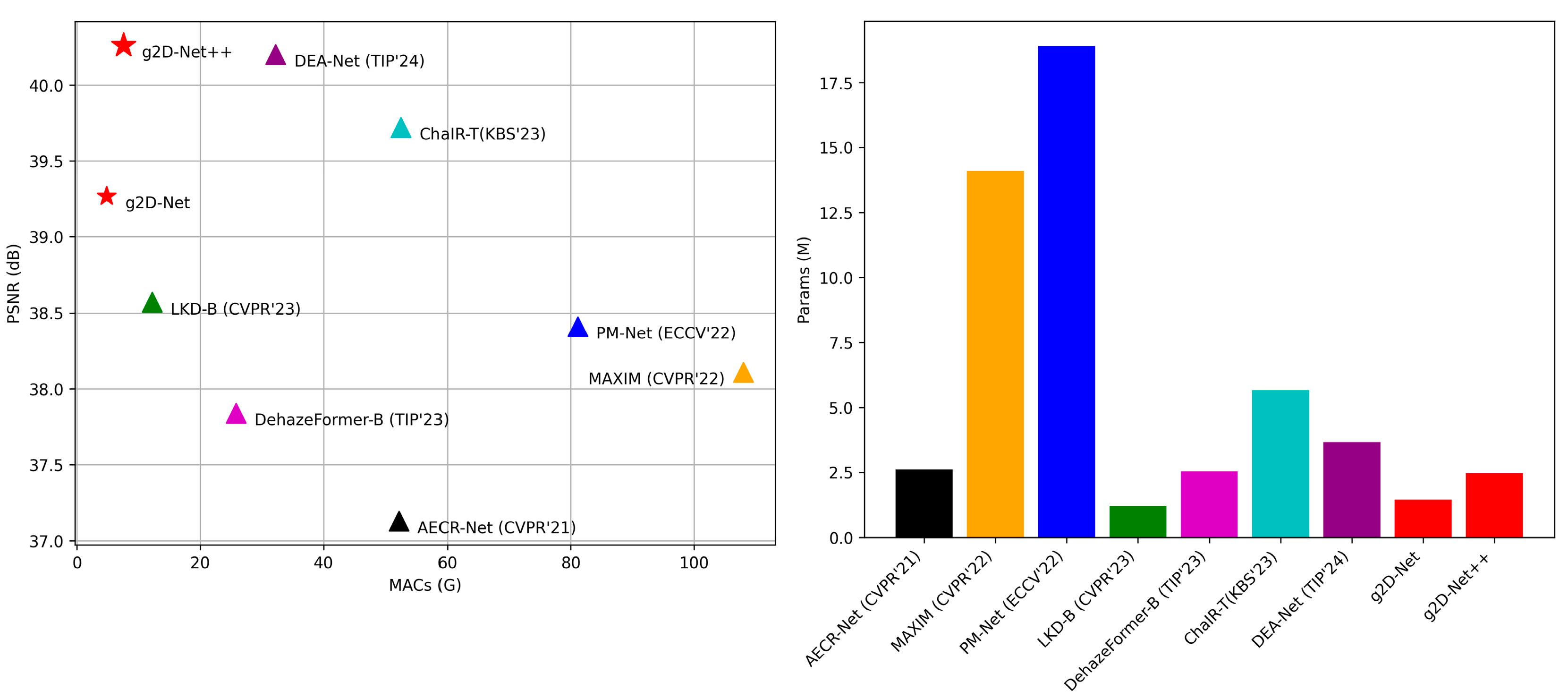
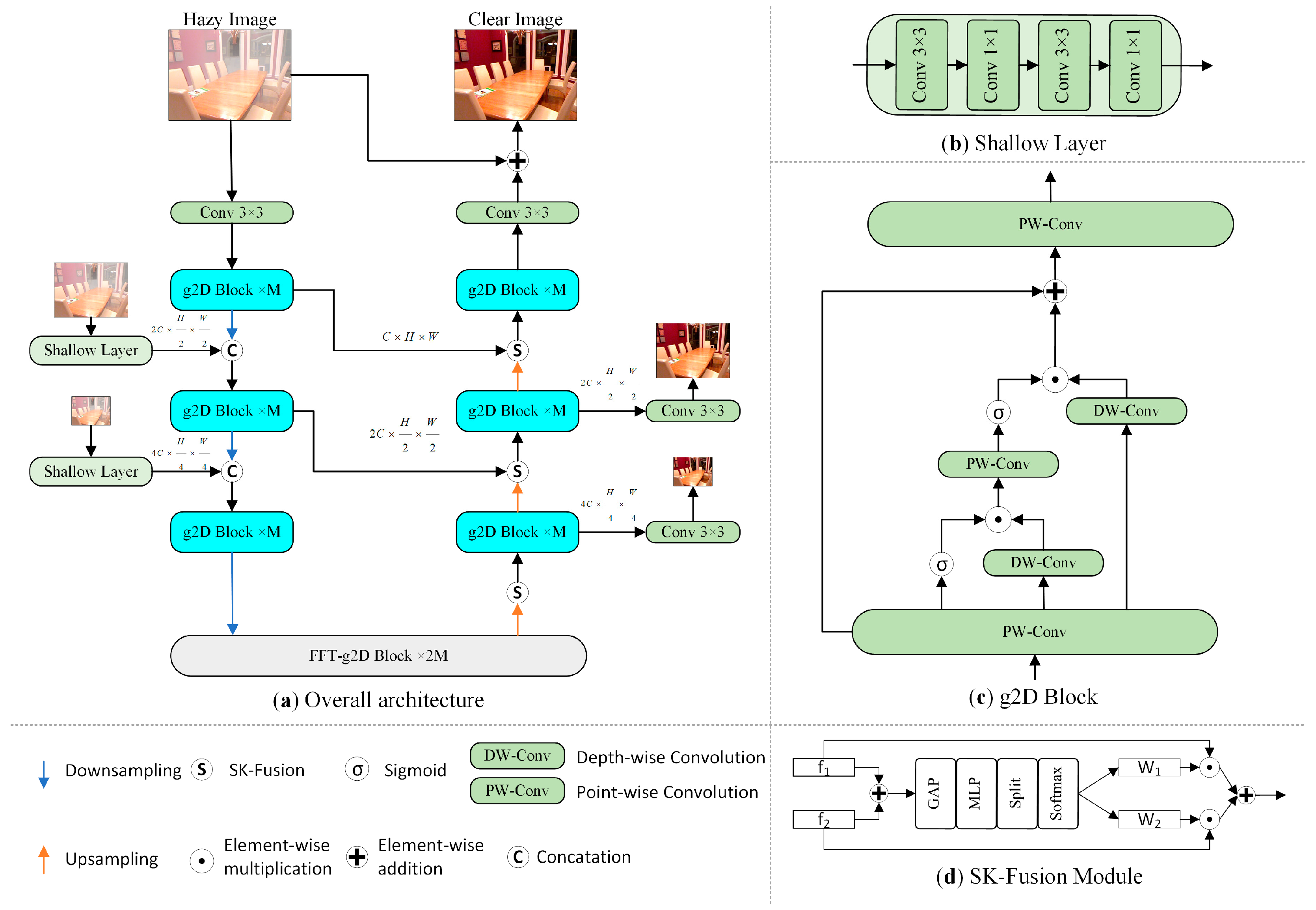
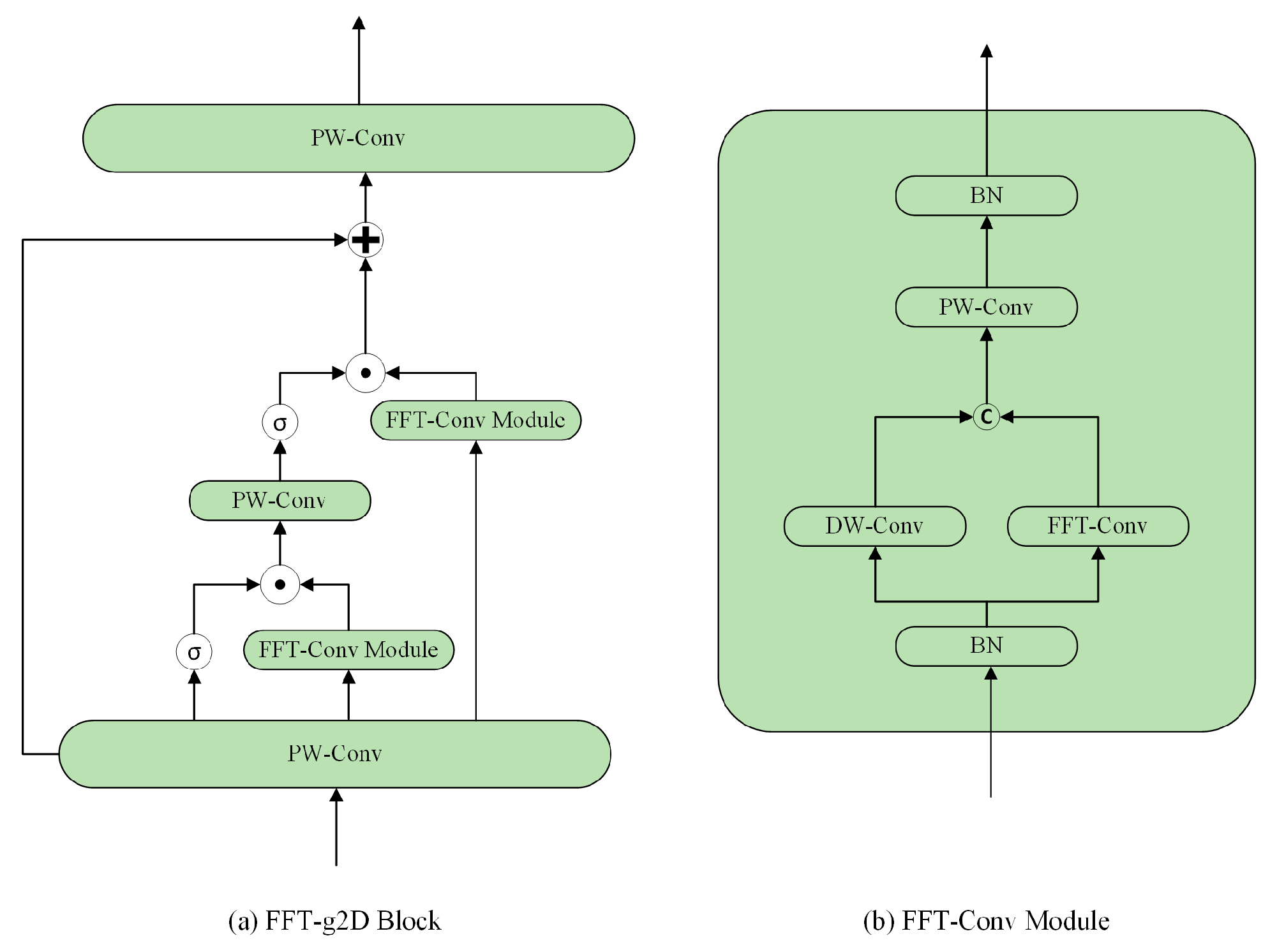

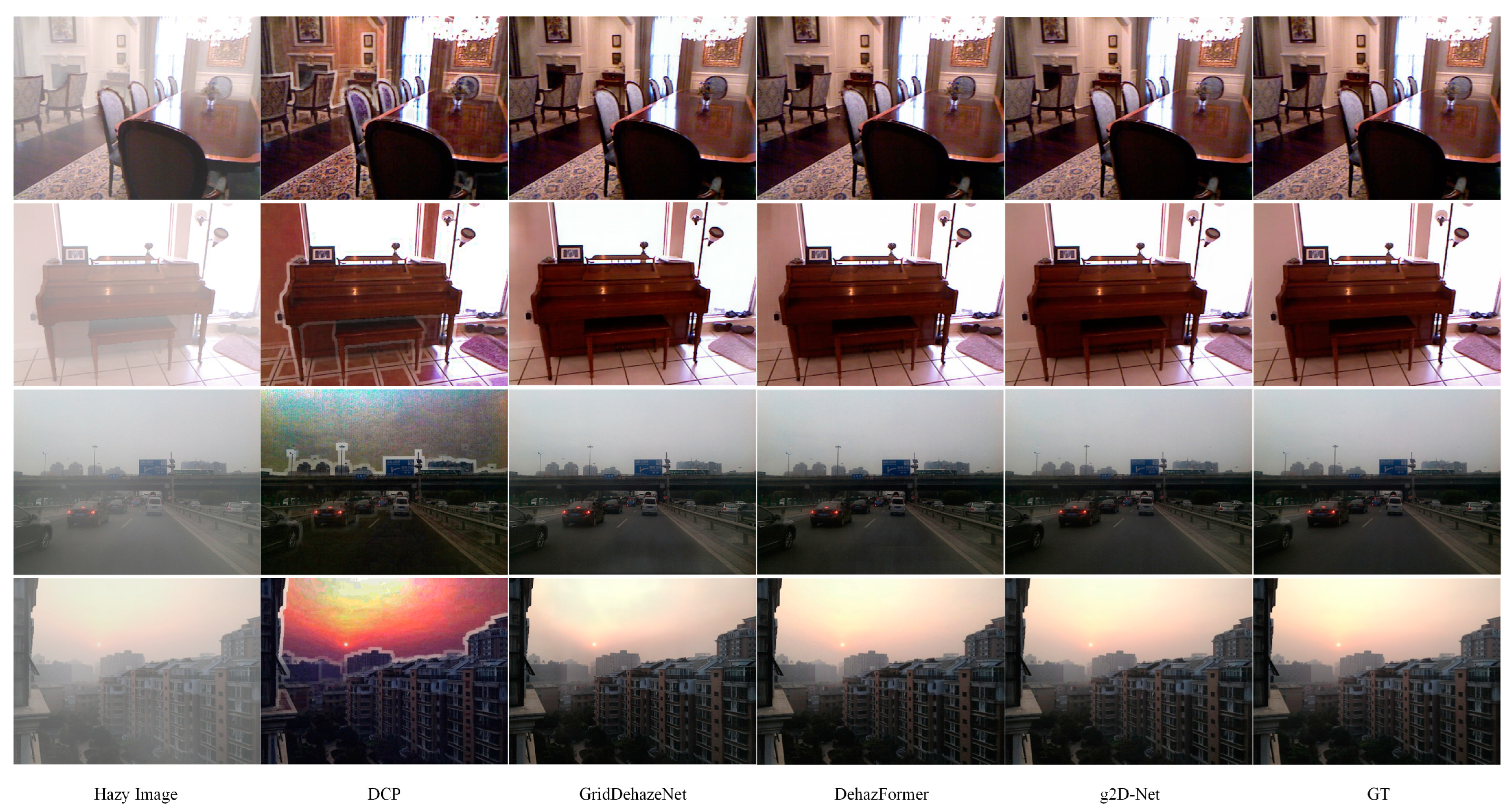
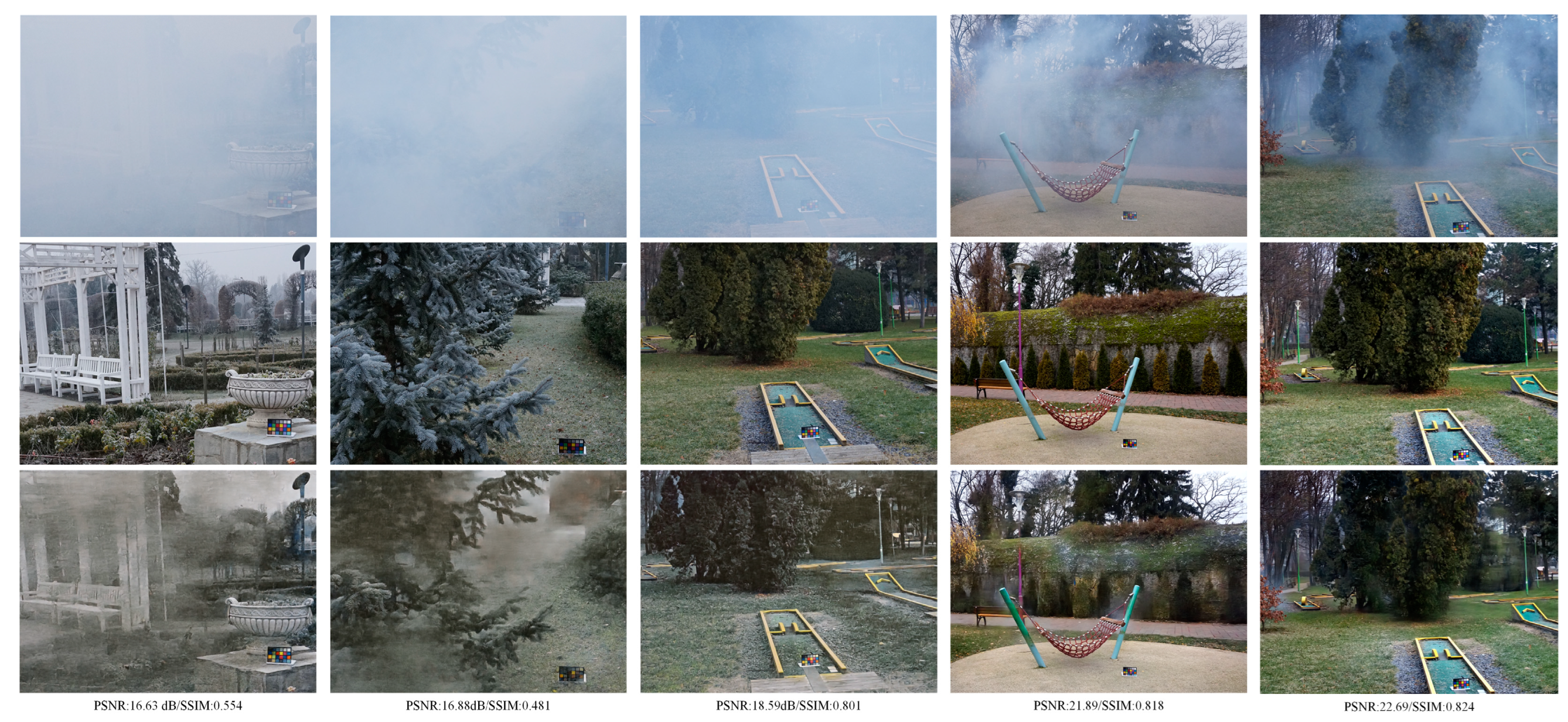
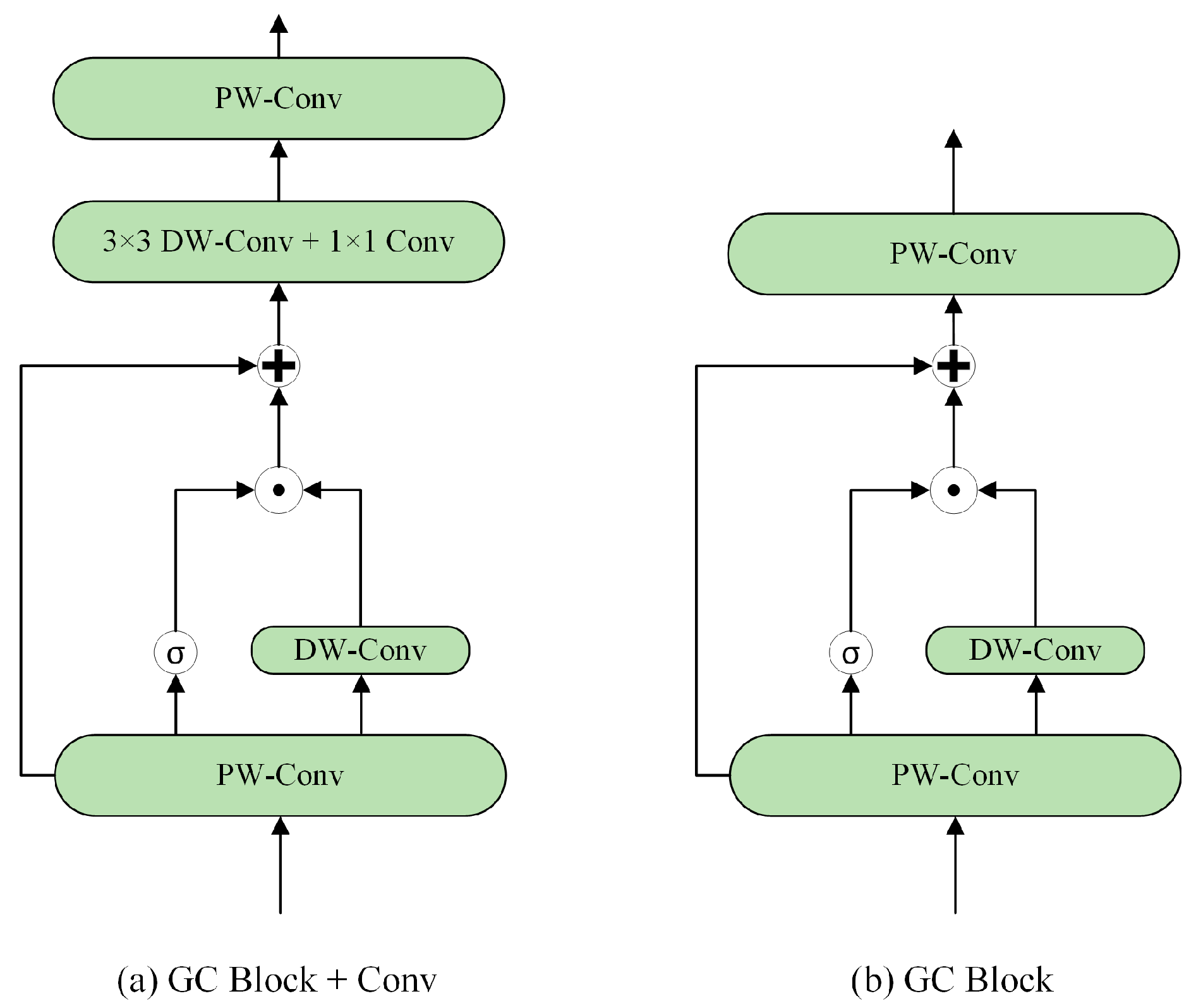
| Model | M | Num. of Blocks | Embedding Dims |
|---|---|---|---|
| g2D-Net | 2 | [2,2,2,4,2,2,2] | [24,48,96,192,96,48,24] |
| g2D-Net++ | 4 | [4,4,4,8,4,4,4] | [24,48,96,192,96,48,24] |
| Model | RESIDE-IN | RESIDE-OUT | Haze4K | Overhead | ||||
|---|---|---|---|---|---|---|---|---|
| PSNR | SSIM | PSNR | SSIM | PSNR | SSIM | MACs(G) | Param(M) | |
| (TPAMI’10) DCP [15] | 16.62 | 0.818 | 19.13 | 0.815 | 14.01 | 0.760 | - | - |
| (TIP’16) DehazeNet [25] | 19.82 | 0.821 | 24.75 | 0.927 | 19.12 | 0.840 | 0.581 | 0.009 |
| (ECCV’16) MSCNN [26] | 19.84 | 0.833 | 22.06 | 0.908 | 14.01 | 0.510 | 0.525 | 0.008 |
| (ICCV’17) AOD-Net [27] | 20.51 | 0.816 | 24.14 | 0.920 | 17.15 | 0.830 | 0.115 | 0.002 |
| (ICCV’19) GridDehazeNet [51] | 32.16 | 0.984 | 30.86 | 0.982 | - | - | 21.49 | 0.956 |
| (AAAI’20) FFA-Net [50] | 36.39 | 0.989 | 33.57 | 0.984 | 26.96 | 0.950 | 287.8 | 4.456 |
| (CVPR’20) MSBDN [52] | 33.67 | 0.985 | 33.48 | 0.982 | 22.99 | 0.850 | 41.54 | 31.35 |
| (ECCV’21) PMNet [53] | 38.41 | 0.990 | 34.74 | 0.985 | - | - | 81.13 | 18.90 |
| (CVPR’22) AECR-Net [54] | 37.13 | 0.990 | - | - | - | - | 52.20 | 2.611 |
| (CVPR’22) MAXIM-2S [28] | 38.11 | 0.991 | 34.19 | 0.985 | - | - | 216 | 14.10 |
| (CVPR’22) DeHamer [36] | 36.63 | 0.998 | 35.18 | 0.986 | - | - | 48.93 | 132.45 |
| (TIP’23) DehazeFormer-B [37] | 37.84 | 0.994 | 34.95 | 0.984 | - | - | 25.79 | 2.541 |
| (ICME’23) LKD-L [55] | 39.44 | 0.994 | 34.82 | 0.983 | - | - | 23.93 | 2.38 |
| (arXiv’23) MixDehazeNet [30] | 39.47 | 0.995 | 35.09 | 0.985 | - | - | 22.06 | 3.16 |
| (ICLR’23) SF-Net [32] | 41.24 | 0.996 | 40.05 | 0.996 | 66.61 | 7.05 | ||
| (KBS’23) ChaIR-T [56] | 39.72 | 0.995 | 38.01 | 0.995 | 5.66 | 52.55 | ||
| (TIP’24) DEA-Net [31] | 40.20 | 0.993 | 36.03 | 0.989 | 33.19 | 0.99 | 32.23 | 3.653 |
| (EAAI’24) HRA-Net [57] | 38.83 | 0.985 | 36.15 | 0.988 | - | - | - | 7.29 |
| g2D-Net | 39.27 | 0.995 | 36.07 | 0.983 | 33.14 | 0.986 | 4.839 | 1.452 |
| g2D-Net++ | 40.26 | 0.996 | 36.60 | 0.985 | 33.24 | 0.986 | 7.560 | 2.466 |
| Model | Dense-Haze | NH-Haze | ||
|---|---|---|---|---|
| PSNR | SSIM | PSNR | SSIM | |
| (ICCV’19) GridDehazeNet [51] | 13.31 | 0.368 | 13.80 | 0.537 |
| (AAAI’20) FFA-Net [50] | 14.39 | 0.407 | 19.87 | 0.692 |
| (CVPR’21) AECR-Net [54] | 15.80 | 0.466 | 19.88 | 0.717 |
| (ECCV’21) PM-Net [53] | 16.79 | 0.510 | 20.42 | 0.730 |
| (CVPR’22) DeHamer [36] | 16.62 | 0.560 | 20.66 | 0.684 |
| (ICCV’23) FocalNet [58] | 17.07 | 0.630 | 20.43 | 0.79 |
| g2D-Net | 17.05 | 0.649 | 20.22 | 0.796 |
| Method | RESIDE-OUT | Overhead | |||
|---|---|---|---|---|---|
| PSNR | SSIM | MACs (G) | Param (M) | Latency (ms) | |
| g2D-Net (Baseline) | 36.07 - | 0.983 - | 4.839 - | 1.452 - | 10.51 - |
| g2D Block (g2D-Net) → GC Block | 35.26 ↓ | 0.983 - | 4.240 ↓ | 1.169 ↓ | 8.78 ↓ |
| g2D Block (g2D-Net) → GC Block + Conv | 35.68 ↓ | 0.983 - | 4.901 ↑ | 1.371 ↓ | 9.72 ↓ |
| g2D Block (g2D-Net++) → GC Block | 36.17 ↑ | 0.983 - | 6.362 ↑ | 1.901 ↑ | 14.41 ↑ |
| FFT-g2D Block → g2D Block | 35.06 ↓ | 0.982 ↓ | 4.542 ↓ | 1.153 ↓ | 9.60 ↓ |
| Multi input/output → Single input/output | 35.32 ↓ | 0.983 - | 3.333 ↓ | 1.217 ↓ | 8.97 ↓ |
| SK layer → Cat layer | 35.31 ↓ | 0.982 ↓ | 5.004 ↑ | 1.471 ↑ | 10.45 ↓ |
| Depth × 2 (g2D-Net++) | 36.60 ↑ | 0.985 ↑ | 7.560 ↑ | 2.446 ↑ | 18.13 ↑ |
| Width × √2 | 36.32 ↑ | 0.983 - | 7.818 ↑ | 2.019 ↑ | 11.47 ↓ |
Disclaimer/Publisher’s Note: The statements, opinions and data contained in all publications are solely those of the individual author(s) and contributor(s) and not of MDPI and/or the editor(s). MDPI and/or the editor(s) disclaim responsibility for any injury to people or property resulting from any ideas, methods, instructions or products referred to in the content. |
© 2024 by the authors. Licensee MDPI, Basel, Switzerland. This article is an open access article distributed under the terms and conditions of the Creative Commons Attribution (CC BY) license (https://creativecommons.org/licenses/by/4.0/).
Share and Cite
Jia, J.; Wang, Z.; Min, J. g2D-Net: Efficient Dehazing with Second-Order Gated Units. Electronics 2024, 13, 1900. https://doi.org/10.3390/electronics13101900
Jia J, Wang Z, Min J. g2D-Net: Efficient Dehazing with Second-Order Gated Units. Electronics. 2024; 13(10):1900. https://doi.org/10.3390/electronics13101900
Chicago/Turabian StyleJia, Jia, Zhibo Wang, and Jeongik Min. 2024. "g2D-Net: Efficient Dehazing with Second-Order Gated Units" Electronics 13, no. 10: 1900. https://doi.org/10.3390/electronics13101900
APA StyleJia, J., Wang, Z., & Min, J. (2024). g2D-Net: Efficient Dehazing with Second-Order Gated Units. Electronics, 13(10), 1900. https://doi.org/10.3390/electronics13101900






